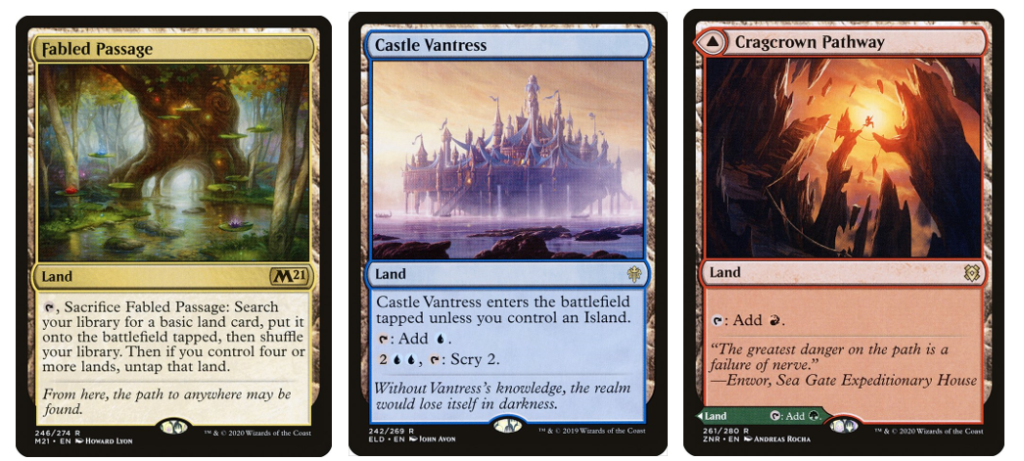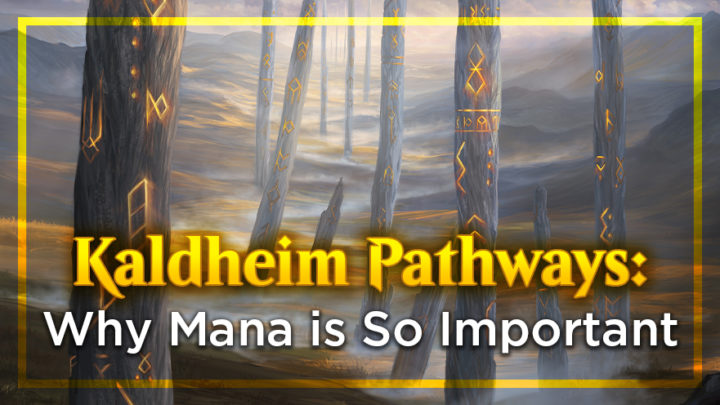I want to let you in on a secret. There’s one aspect of Magic: The Gathering that defines everything we do in the game, but we don’t think or talk about it as much as we should. I’m not talking about mulliganing, sideboarding, or card advantage — I’m talking about mana. Lands are some of the most impactful cards in a metagame — more impactful than the creatures and Planeswalker cards that typically get the spotlight.
Today, we are going to talk about why mana so important and how to build decks with mana in mind. Mana is what allows us to play the game in the first place; if you don’t have access to enough mana, or enough of certain types of mana, your deck will suffer under that strain. Stretching your mana too far is an easy way to rack up losses; Magic is already a game of variance and tempting it by stretching your mana is a classic recipe for disaster.
But why is that? How much does mana limit us? How much should access to good mana affect our deck-building and deck choices? Those are all topics we’re going to cover today.
Case Study: Pathway Lands

To help frame this discussion, I want to focus on the Pathways — a cycle of ten lands introduced in Zendikar Rising that will be completed with the release of Kaldheim. These lands have a huge influence on what decks we can build in Standard, and for that very reason, they illustrate why mana is so important.
Before we dive into the big questions, it’s helpful to understand the Pathways’ strengths and weaknesses. Pathways are untapped “dual” lands. We don’t have to worry about these lands coming in tapped, so we should be able to cast our spells on curve without sacrificing tempo or life. This makes the Pathways useful in a variety of decks, from aggro to control.
But the biggest drawback of these Pathways — and the reason I put “dual” in quotes — is that they only create one color of mana once they’re in play. Whenever you play a Pathway, you have to commit to one side of the card for the rest of the game — often with limited information. So, while these lands give us a level of flexibility, they don’t have the same impact as the Ravnica shock lands from the last few years.
These strengths and weaknesses affect the types of decks we can build with Pathways — which, in turn, affects what the Standard metagame will look like.
Why is mana so important?
Mana is the foundation of Magic itself. If you cannot consistently cast your spells, then you are ultimately behind your opponent on cards. So, in a way, good mana is a form of card advantage.
Let’s say your opponent is playing a three-color deck with lots of different color requirements. If they don’t have access to the right mana at the right time, they won’t be able to consistently cast the spells they want on turns two through five. Meanwhile, your mono-red deck will just need any land to cast its spells. This sort of thing is not talked about enough in Magic, but it’s a pivotal reason why decks like Mono-Red can thrive in certain fields.

Conversely, if your mana is really good and you’re able to easily support spells of three or more colors, you’ll typically be able to overpower mono-colored aggro decks. As one of the biggest benefits they have is nearly “perfect” mana, and if you’re able to match them in that regard, your superior card quality will likely win out.
The current Standard metagame illustrates this lesson clearly. Every competitive deck is either a mono-colored deck or a deck that benefits the most from the Pathways we have. Esper Doom, Dimir Rogues, Gruul, Mono-Green, Dimir Control — all these multicolored decks have one or two Pathways to utilize. These decks are also built with the Pathways in mind — with a lot of cards that have a single colored mana symbol in their casting costs and very few gold cards. The fewer gold cards you have, the more forgiving your mana base will be when you’re choosing which side of your Pathway to play.

How much does mana limit us?
While Pathways provide each of these Standard decks with flexibility, they also show how much mana can limit us.
There are plenty of other decks that have popped up in Standard in the past few months but didn’t have staying power. While there are a variety of reasons these decks didn’t succeed, the most common throughline is bad mana. Rakdos Midrange, Golgari Adventures, and Azorius Yorion all started out strong during Standard’s formative period, but not every deck that has an early breakout can stand the test of time. As the format developed, these decks’ couldn’t consistently do their thing because they didn’t have access to the right mana sources, and that prevented them from becoming serious contenders. With the new Pathways in Kaldheim, that might change.

But the Pathways aren’t the only dual lands in Standard that can limit our deck-building options. Both the Triomes and Temples all enter play tapped, which poses serious problems for aggro decks. If the metagame is full of fast and efficient cards, decks will need to find ways to mitigate the tempo loss of playing tap lands. We see Rogues do it by utilizing lots of cheap cards to fill in the curve during the awkward early turns.
Playing tap lands in the first few turns isn’t always so bad, but what if you draw them later in the game? Sometimes, drawing a tap land on a pivotal turn will prevent you from playing expensive, impactful cards. If you’re trying to get to the late game — and decks playing three or more colors typically are — having a large chunk of lands in your deck that enter play tapped will make it harder for you to consistently play larger spells on curve.
This is something that decks like Gruul don’t have to worry about, which helps explain why they’re so successful. Once Gruul has four lands in play, all its lands will enter untapped. With access to untapped mana sources like the Pathways, decks like Gruul and Rogues are able to continuously roll out their threats, further punishing any decks that play too many lands that enter play tapped.

It’s important to remember that, while mana is a major factor in a deck’s success, it’s far from the only one. For example, Green-White decks have access to a Pathway, but none have seen lasting success in Standard. Mana helps, but card quality and other metagame dynamics will determine a deck’s positioning, too.
How much should mana affect my deck-building strategy?
Assuming your main goal is to win a tournament, mana availability should be a large factor in your deck choice. In some ways, mana availability makes your deck choices for you. Wizards of the Coast is aware of the mana we have and the restrictions, and they design cards with both in mind. If you try to build a deck regardless of what mana sources are available, your deck is going to suffer more, so the power level will need to be much higher.
That can sound like a bad thing, but it isn’t. Executing your plan consistently and smoothly will increase your win rate, plain and simple. I wish there was some secret I could give you to sidestep this, but that’s sadly not the case. Coming to terms with the fact that mana rules the world will make your overall experience a better one.

Hopefully, you’ve learned just how much mana matters when it comes to building and choosing a deck. Our Standard mana is about to get an upgrade thanks to the completion of the Pathway cycle, and that should allow a wider variety of decks to find their place in the metagame.
What decks are you hoping to play in Standard with Kaldheim? Tweet at @masoneclark and @card_kingdom and let us know!

Mason Clark is a grinder in every corner of the game who has played at the pro level and on the SCG Tour with Team Nova. Whether he’s competing in Standard, Historic or Modern, Mason plays with one goal in mind: to be a better player than he was the day before. Check out his podcast, Constructed Criticism, and catch his streams on Twitch.

